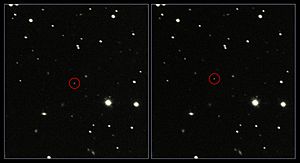Gaia (spacecraft) facts for kids
Gaia is a special space telescope launched by the ESA. It blasted off on December 19, 2013. Its main job is to create a super-detailed 3D map of about one billion objects in space.
Gaia is studying about 1% of the stars in our home galaxy, the Milky Way. It's like a follow-up mission to an older telescope called Hipparcos. Gaia is part of ESA's big plan for science missions. It will look at each of its target stars around 70 times over five years.
Gaia's goal is to make an incredibly precise 3D map of stars across the Milky Way galaxy. It will also track how these stars are moving. This information helps scientists understand how the Milky Way began and how it has changed over time. Gaia also uses special tools to measure things like how bright a star is, its temperature, its gravity, and what elements it's made of.
By counting and studying so many stars, Gaia gives astronomers a lot of basic information. With this data, they hope to solve big mysteries. These include how our galaxy started, what it looks like, and how it has grown. Gaia also measures many other things. These include quasars, galaxies, extrasolar planets (planets outside our Solar System), and objects in our own Solar System.
Launching Gaia
Gaia was launched into space using a Soyuz rocket. It took off from the GSC in French Guiana. Once in space, Gaia doesn't just orbit Earth. It operates in a special path called a Lissajous orbit. This orbit is around a point in space called the Sun–Earth L2 Lagrangian point. This spot is perfect because the gravity from the Sun and Earth balances out there. This makes it a stable place for a telescope to stay and observe.
Images for kids
-
Gaia's HR Diagram
-
Four maps of the galaxy: radial velocity (top left), proper motion (bottom left); interstellar dust (top right); and metallicity (bottom right).
-
12 Einstein crosses discovered by Gaia in 2021
See also
 In Spanish: Gaia (sonda espacial) para niños
In Spanish: Gaia (sonda espacial) para niños









